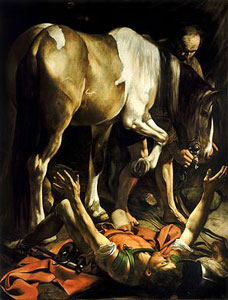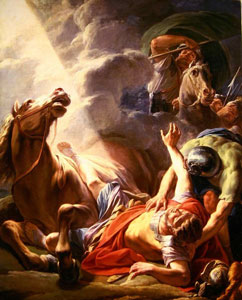On January 25 we remember how Saul (or Paul) of Tarsus, formerly a persecutor of the early Christian Church, was led by God’s grace to become one of its chief spokesmen. Here are two art works that depict the event :


“The Conversion on the Way to Damascus; ” (1601) “ The Conversion of St. Paul ” Nicolas-Bernard Lepicie, 1767
"and suddenly a light from heaven shined round about him. And falling on the ground, he heard a voice saying to him: Saul, Saul, why persecutest thou me? Who said: Who art thou, Lord? And he: I am Jesus whom thou persecutest. " Acts 9: 3-5
Italian painter Caravaggio painted the one on the left in 1601 for the Cerasi Chapel of the church of Santa Maria del Popolo, in Rome. The painting depicts the moment recounted in Chapter 9 of Acts of the Apostles when Saul, soon to be the apostle Paul, fell on the road to Damascus.
Caravaggio is close to the Bible. The horse is there and, to hold him, a groom, but the drama is internalized within the mind of Saul. There is no heavenly apparition. He lies on the ground stunned, his eyes closed as if dazzled by the light.
Caravaggio’s style featured a dark background with usually one point of breaking light. Paul is flung off of his horse and is seen on his back on the ground. Although Paul reflects the most light out of all the characters, the attention is given to him in a strange way. Because Paul is on the ground, he is much smaller than the horse, which is also at the center of the painting but he is pictured closer to the viewer.
The second painting constrast with Caravaggio in the use of color and light. This one has some of the most vibrant colors. Heaven’s light is shown coming dynamically from left to right. The painting is like the key frame in a movie on the conversion. At the time Lepicie was a professor at the Royal Academy of Painting and Sculpture in Paris
A hymn by John Ellerton in 1871 celebrates the event. Here is the first verse.
1 We sing the glorious conquest
before Damascus gate,
when Saul, the church’s spoiler,
came breathing threats and hate;
the rav’ning wolf rushed forward
full early to the prey;
but lo! the Shepherd met him,
and bound him fast today.
"Exactly when Paul began his bloody mission of savagery against the church of Christ is unknown with any degree of precision. The fear of him was significant, and those beyond the borders of Palestine trembled at the mention of the name of this “wolf” who stalked “the fold of the Lamb” (Acts 9:13,26; cf. 26:11).
"Saul of Tarsus first appears in the biblical record as a witness to the stoning of Stephen, the first martyr to the cause of Christ—even “consenting” to his death (Acts 7:58; 9:1). Henceforth his persecution of Christians, as portrayed in the book of Acts via his own testimony, was relentless—though he thought sincerely he was doing Jehovah’s will (23:1; 26:9). Pursuing the saints even unto foreign cities (26:11), he beat, imprisoned, and had them put to death (22:19). Later he would write that “beyond measure I persecuted the church of God, and made havoc of it” (Galatians 1:13). The horrible memories of these vicious attacks would linger with the sensitive apostle for the balance of his earthly days (cf. 1 Corinthians 15:9; Ephesians 3:8; 1 Timothy 1:15).
"That frenzied ambition to exterminate Christianity from the face of the earth was to radically change, however. And the record of how that occurred is as amazing as it is inspiring.
The Conversion
"According to Luke’s historical record (Acts 9:1ff), Saul, armed with arrest warrants for those of the Christian Way, departed from Jerusalem en route to ancient Damascus, some 140 miles to the north. As he drew near that city, a light brighter than the noonday sun suddenly engulfed him. A voice inquired: “Saul, Saul, why do you continue to persecute me?” The double use of his name suggests a reproof (cf. Matthew 23:37; Luke 10:41; 22:31). Saul responded: “Who are you, Lord?” The title “Lord” was employed at this point as a mere term of respect, for he knew not who had addressed him.
"The voice was identified as Jesus of Nazareth! The stunned persecutor was instructed to enter Damascus where he would be informed as to what he “must do.” Blinded as a consequence of this miraculous vision in which Christ actually appeared to him (9:17; 1 Corinthians 15:8), Saul was led into the city.
"For three agonizing days he fasted and prayed. Finally, Ananias, a messenger selected by God, arrived. He restored Saul’s sight and commanded him to “arise, and be baptized, and wash away your sins, calling on his name” (Acts 22:16). After certain days passed, the former persecutor began to proclaim among his fellow Jews that Jesus “is the Son of God” (see Acts 9:19-22)."
